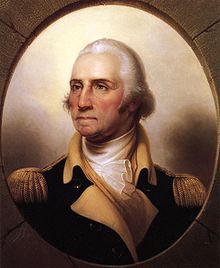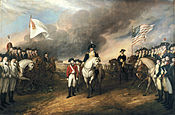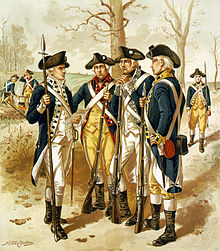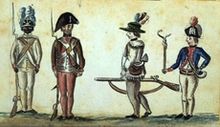- Continental Army
-
American Revolutionary War Armed Forces United States Continental Army → Commander-in-Chief → Regional departments → Units (1775, 1776, 1777–1784) Continental Navy Continental Marines State forces → List of militia units → List of state navies → Maritime units Great Britain List of British units France List of French units Related topics List of battles Military leadership The Continental Army was formed after the outbreak of the American Revolutionary War by the colonies that became the United States of America. Established by a resolution of the Continental Congress on June 14, 1775, it was created to coordinate the military efforts of the Thirteen Colonies in their revolt against the rule of Great Britain. The Continental Army was supplemented by local militias and other troops that remained under control of the individual states. General George Washington was the Commander-in-Chief of the army throughout the war.
Most of the Continental Army was disbanded in 1783 after the Treaty of Paris ended the war. The remaining units possibly formed the nucleus of what became the United States Army.
Contents
Creation
The Continental Army consisted of troops from all 13 colonies. When the American Revolutionary War began at the Battles of Lexington and Concord in April 1775, the colonial revolutionaries did not have an army. Previously, each colony had relied upon the militia, made up of part time citizen-soldiers, for local defense, or the raising of temporary "provincial regiments" during specific crises such as the French and Indian War. As tensions with Great Britain increased in the years leading up to the war, colonists began to reform their militia in preparation for the potential conflict. Training of militiamen increased after the passage of the Intolerable Acts in 1774. Colonists such as Richard Henry Lee proposed creating a national militia force, but the First Continental Congress rejected the idea.[1]
The minimum enlistment age was 16 years of age, or 15 with parental consent.
On April 23, 1775, the Massachusetts Provincial Congress authorized the raising of a colonial army consisting of 26 company regiments, followed shortly by similar but smaller forces raised by New Hampshire, Rhode Island, and Connecticut. On June 14, 1775, the Second Continental Congress decided to proceed with the establishment of a Continental Army for purposes of common defense, adopting the forces already in place outside Boston (22,000 troops) and New York (5,000). It also raised the first ten companies of Continental troops on a one-year enlistment, riflemen from Pennsylvania, Maryland, Delaware and Virginia to be used as light infantry, who later became the 1st Continental Regiment in 1776. On June 15, the Congress elected George Washington as Commander-in-Chief by unanimous vote. He accepted and served throughout the war without any compensation except for reimbursement of expenses.
Four major-generals (Artemas Ward, Charles Lee, Philip Schuyler, and Israel Putnam) and eight brigadier-generals (Seth Pomeroy, Richard Montgomery, David Wooster, William Heath, Joseph Spencer, John Thomas, John Sullivan, and Nathanael Greene) were appointed in the course of a few days. Pomeroy declined and the position was left unfilled.
 General George Washington was appointed Commander-in-Chief of the Continental Army on June 15, 1775.
General George Washington was appointed Commander-in-Chief of the Continental Army on June 15, 1775.
As the Continental Congress increasingly adopted the responsibilities and posture of a legislature for a sovereign state, the role of the Continental Army was the subject of considerable debate. There was a general aversion to maintaining a standing army among the Americans; but, on the other hand, the requirements of the war against the British required the discipline and organization of a modern military. As a result, the army went through several distinct phases, characterized by official dissolution and reorganization of units.
Soldiers in the Continental Army were citizens who had volunteered to serve in the army (but were paid), and at various times during the war, standard enlistment periods lasted from one to three years. Early in the war, the enlistment periods were short, as the Continental Congress feared the possibility of the Continental Army evolving into a permanent army. The army never reached over 17,000 men. Turnover was a constant problem, particularly in the winter of 1776-77, and longer enlistments were approved. Broadly speaking, Continental forces consisted of several successive armies, or establishments:
- The Continental Army of 1775, comprising the initial New England Army, organized by Washington into three divisions, six brigades, and 38 regiments. Major General Philip Schuyler's ten regiments in New York were sent to invade Canada.
- The Continental Army of 1776, reorganized after the initial enlistment period of the soldiers in the 1775 army had expired. Washington had submitted recommendations to the Continental Congress almost immediately after he had accepted the position of Commander-in-Chief, but these took time to consider and implement. Despite attempts to broaden the recruiting base beyond New England, the 1776 army remained skewed toward the Northeast both in terms of its composition and geographical focus. This army consisted of 36 regiments, most standardized to a single battalion of 768 men strong formed into eight companies, with a rank and file strength of 640.
- The Continental Army of 1777-80 was a result of several critical reforms and political decisions that came about when it was apparent that the British were sending massive forces to put an end to the American Revolution. The Continental Congress passed the "Eighty-eight Battalion Resolve", ordering each state to contribute one-battalion regiments in proportion to their population, and Washington was subsequently given authority to raise an additional 16 battalions. Also, enlistment terms were extended to three years or "the length of the war" to avoid the year-end crises that depleted forces (including the notable near collapse of the army at the end of 1776 which could have ended the war in a Continental, or American, loss by forfeit).
- The Continental Army of 1781-82 saw the greatest crisis on the American side in the war. Congress was bankrupt, making it very difficult to replenish the soldiers whose three-year terms had expired. Popular support for the war was at its all-time low, and Washington had to put down mutinies both in the Pennsylvania Line and New Jersey Line. Congress voted to cut funding for the Army, but Washington managed nevertheless to secure important strategic victories.
- The Continental Army of 1783-84, was succeeded by the United States Army, which persists to this day. As peace was closed with the British, most of the regiments were disbanded in an orderly fashion, though several had already been diminished.
In addition to the Continental Army regulars, local militia units, raised and funded by individual colonies/states, participated in battles throughout the war. Sometimes, the militia units operated independently of the Continental Army, but often local militias were called out to support and augment the Continental Army regulars during campaigns. (The militia troops developed a reputation for being prone to premature retreats, a fact that was integrated into the strategy at the Battle of Cowpens.)
The financial responsibility for providing pay, food, shelter, clothing, arms, and other equipment to specific units was assigned to states as part of the establishment of these units. States differed in how well they lived up these obligations. There were constant funding issues and morale problems as the war continued. This led to the army offering low pay, often rotten food, hard work, cold, heat, poor clothing and shelter, harsh discipline, and a high chance of becoming a casualty.
Operations
 1778 Drawing of a member of the Stockbridge Militia (from Revolutionary War diary of Johann Von Ewald)
1778 Drawing of a member of the Stockbridge Militia (from Revolutionary War diary of Johann Von Ewald)
At the time of the Siege of Boston, the Continental Army at Cambridge, Massachusetts, in June 1775, is estimated to have numbered from 14-16,000 men from New England (though the actual number may have been as low as 11,000 because of desertions). Until Washington's arrival, it remained under the command of Artemas Ward, while John Thomas acted as executive officer and Richard Gridley commanded the artillery corps and was chief engineer.
The British force in Boston was increasing by fresh arrivals. It numbered then about 10,000 men. Major Generals Howe, Clinton, and Burgoyne, had arrived late in May and joined General Gage in forming and executing plans for dispersing the rebels. Feeling strong with these veteran officers and soldiers around him—and the presence of several ships-of-war under Admiral Graves—the governor issued a proclamation, declaring martial law, branding the entire Continental Army and supporters as "rebels" and "parricides of the Constitution." Amnesty was offered to those who gave up their allegiance to the Continental Army and Congress in favor of the British authorities, though Samuel Adams and John Hancock were still wanted for high treason. This proclamation only served to strengthen the resolve of the Congress and Army.
After the British evacuation of Boston (prompted by the placement of Continental artillery overlooking the city in March 1776), the Continental Army relocated to New York. For the next five years, the main bodies of the Continental and British armies campaigned against one another in New York, New Jersey, and Pennsylvania. These campaigns included the notable battles of Trenton, Princeton, Brandywine, Germantown, and Morristown, among many others.
The Continental Army was racially integrated, a condition the United States Army would not see again until the Korean War. Negro slaves were promised freedom in exchange for military service in New England, and made up one fifth of the Northern Continental Army.[2]
Throughout its existence, the Army was troubled by poor logistics, inadequate training, short-term enlistments, interstate rivalries, and Congress's inability to compel the states to provide food, money or supplies. In the beginning, soldiers enlisted for a year, largely motivated by patriotism; but as the war dragged on, bounties and other incentives became more commonplace. Two major mutinies late in the war drastically diminished the reliability of two of the main units, and there were constant discipline problems.
The army increased its effectiveness and success rate through a series of trials and errors, often at great human cost. General Washington and other distinguished officers were instrumental leaders in preserving unity, learning and adapting, and ensuring discipline throughout the eight years of war. In the winter of 1777-1778, with the addition of Baron von Steuben, of Prussian origin, the training and discipline of the Continental Army began to vastly improve. (This was the infamous winter at Valley Forge.) Washington always viewed the Army as a temporary measure and strove to maintain civilian control of the military, as did the Continental Congress, though there were minor disagreements about how this was carried out.
Near the end of the war, the Continental Army was augmented by a French expeditionary force (under General Rochambeau) and a squadron of the French navy (under the Comte de Barras), and in the late summer of 1781 the main body of the army travelled south to Virginia to rendezvous with the French West Indies fleet under Admiral Comte de Grasse. This resulted in the Siege of Yorktown, the decisive Battle of the Chesapeake, and the surrender of the British southern army. This essentially marked the end of the land war in America, although the Continental Army returned to blockade the British northern army in New York until the peace treaty went into effect two years later, and battles took place elsewhere between British forces and those of France and its allies.
Demobilization
See also: Newburgh ConspiracyA small residual force remained at West Point and some frontier outposts until Congress created the United States Army by their resolution of June 3, 1784.
Planning for the transition to a peacetime force had begun in April 1783 at the request of a congressional committee chaired by Alexander Hamilton. The Commander-in-Chief discussed the problem with key officers before submitting the Army's official views on 2 May. Significantly, there was a broad consensus of the basic framework among the officers. Washington's proposal called for four components: a small regular army, a uniformly trained and organized militia, a system of arsenals, and a military academy to train the army's artillery and engineer officers. He wanted four infantry regiments, each assigned to a specific sector of the frontier, plus an artillery regiment. His proposed regimental organizations followed Continental Army patterns but had a provision for increased strength in the event of war. Washington expected the militia primarily to provide security for the country at the start of a war until the regular army could expand—the same role it had carried out in 1775 and 1776. Steuben and Duportail submitted their own proposals to Congress for consideration.
Although Congress declined on 12 May to make a decision on the peace establishment, it did address the need for some troops to remain on duty until the British evacuated New York City and several frontier posts. The delegates told Washington to use men enlisted for fixed terms as temporary garrisons. A detachment of those men from West Point reoccupied New York without incident on 25 November. When Steuben's effort in July to negotiate a transfer of frontier forts with Maj. Gen. Frederick Haldimand collapsed, however, the British maintained control over them, as they would into the 1790s. That failure and the realization that most of the remaining infantrymen's enlistments were due to expire by June 1784 led Washington to order Knox, his choice as the commander of the peacetime army, to discharge all but 500 infantry and 100 artillerymen before winter set in. The former regrouped as Jackson's Continental Regiment under Col. Henry Jackson of Massachusetts. The single artillery company, New Yorkers under John Doughty, came from remnants of the 2nd Continental Artillery Regiment.
Congress issued a proclamation on 18 October 1783 which approved Washington's reductions. On 2 November Washington then released his Farewell Order to the Philadelphia newspapers for nationwide distribution to the furloughed men. In the message he thanked the officers and men for their assistance and reminded them that "the singular interpositions of Providence in our feeble condition were such, as could scarcely escape the attention of the most unobserving; while the unparalleled perseverance of the Armies of the U[nited] States, through almost every possible suffering and discouragement for the space of eight long years, was little short of a standing miracle."
 Continental Army Plaza, Williamsburg, Brooklyn
Continental Army Plaza, Williamsburg, Brooklyn
Washington believed that the blending of persons from every colony into "one patriotic band of Brothers" had been a major accomplishment, and he urged the veterans to continue this devotion in civilian life.
Washington said farewell to his remaining officers on 4 December at Fraunces Tavern in New York City. On 23 December he appeared in Congress, then sitting at Annapolis, and returned his commission as Commander-in-Chief: "Having now finished the work assigned me, I retire from the great theatre of Action; and bidding an Affectionate farewell to this August body under whose orders I have so long acted, I here offer my Commission, and take my leave of all the employments of public life." Congress ended the War of American Independence on 14 January 1784 by ratifying the definitive peace treaty that had been signed in Paris on 3 September.
Congress had again rejected Washington's concept for a peacetime force in October 1783. When moderate delegates then offered an alternative in April 1784 which scaled the projected army down to 900 men in 1 artillery and 3 infantry battalions, Congress rejected it as well, in part because New York feared that men retained from Massachusetts might take sides in a land dispute between the two states. Another proposal to retain 350 men and raise 700 new recruits also failed. On 2 June Congress ordered the discharge of all remaining men except twenty-five caretakers at Fort Pitt and fifty-five at West Point. The next day it created a peace establishment acceptable to all interests.
The plan required four states to raise 700 men for one year's service. Congress instructed the Secretary at War to form the troops into 8 infantry and 2 artillery companies. Pennsylvania, with a quota of 260 men, had the power to nominate a lieutenant colonel, who would be the senior officer. New York and Connecticut each were to raise 165 men and nominate a major; the remaining 110 men came from New Jersey. Economy was the watchword of this proposal, for each major served as a company commander, and line officers performed all staff duties except those of chaplain, surgeon, and surgeon's mate. Under Josiah Harmar, the First American Regiment slowly organized and achieved permanent status as an infantry regiment of the new Regular Army. The Lineage of the 1st American Regiment is carried on by the 3rd United States Infantry Regiment (The Old Guard).
Led by Continental veterans, this small peacetime Regular Army gradually expanded over the next decade. It had inherited the rules, regulations, and traditions of the Continental Army. Steuben's Blue Book remained the official manual for the regulars, as well as for the militia of most states, until Winfield Scott in 1835 adapted the 1791 French Army Regulations for American use. At the Battle of Fallen Timbers in 1794, Maj. Gen. Anthony Wayne applied the techniques of wilderness operations perfected by Sullivan's 1779 expedition against the Iroquois. The integration of ex-Continentals into the militia, coupled with the passage in 1792 of a national militia bill, improved the military responsiveness of that institution until the veterans began to age.
Rank Insignia
During the American Revolution, the Continental Army initially wore cockades of various colors as an ad hoc form of rank insignia, as General George Washington wrote:
As the Continental Army has unfortunately no uniforms, and consequently many inconveniences must arise from not being able to distinguish the commissioned officers from the privates, it is desired that some badge of distinction be immediately provided; for instance that the field officers may have red or pink colored cockades in their hats, the captains yellow or buff, and the subalterns green.Later on in the war, the continental army established its own uniform with a black cockade (as used in much of the British Army) among all ranks and the following insgnia:
Officer Rank Structure of the Continental Army Major General Brigadier General Colonel Lieutenant Colonel Major Captain Lieutenant Ensign 

No Insignia No Insignia No Insignia No Insignia No Insignia No Insignia Major battles
- Siege of Boston
- Battle of Long Island
- Battle of Harlem Heights
- Battle of Trenton
- Battle of Princeton
- Battle of Brandywine
- Battle of Germantown
- Battle of Saratoga
- Battle of Monmouth
- Siege of Charleston
- Battle of Camden
- Battle of Cowpens
- Battle of Guilford Court House
- Siege of Yorktown
See also
- Departments of the Continental Army
- Pluckemin Continental Artillery Cantonment Site
- History of the United States Army
- Peter Francisco
- Middlebrook encampment in Middlebrook, New Jersey, winter of 1776-1777 and winter of 1778-779
- Valley Forge in Valley Forge, Pennsylvania, winter of 1777-1778
References
Notes
- ^ Wright, Continental Army, p. 10–11
- ^ Liberty! The American Revolution (Documentary) Episode II: Blows Must Decide: 1774-1776. Twin Cities Public Television, 1997. ISBN 1-4157-0217-9
Further reading
- Lengel, Edward G. General George Washington: A Military Life. New York: Random House, 2005. ISBN 1400060818.
- Royster, Charles. A Revolutionary People at War: The Continental Army and American Character, 1775–1783. Chapel Hill: University of North Carolina Press, 1979. ISBN 0807813850.
- Carp, E. Wayne. To Starve the Army at Pleasure: Continental Army Administration and American Political Culture, 1775–1783. Chapel Hill: University of North Carolina Press, 1984. ISBN 080781587X.
- Gillett, Mary C. The Army Medical Department, 1775–1818. Washington: Center of Military History, U.S. Army, 1981.
- Martin, James Kirby, and Mark Edward Lender. A Respectable Army: The Military Origins of the Republic, 1763–1789. 2nd ed. Wheeling, Illinois: Harlan Davidson, 2006. ISBN 0882952390.
- Mayer, Holly A. Belonging to the Army: Camp Followers and Community during the American Revolution. Columbia: University of South Carolina Press, 1999. ISBN 1570033390; ISBN 1570031088.
- Risch, Erna (1981). Supplying Washington's Army. Washington, D.C.: United States Army Center of Military History. http://www.history.army.mil/books/RevWar/risch/risch-fm.htm.
External links
- Reference materials
- RevWar75.com provides "an online cross-referenced index of all surviving orderly books of the Continental Army".
- Wright, Robert K. The Continental Army. Washington, D.C.: United States Army Center of Military History 1983. Available, in part, online from the CMH website
- Bibliography of the Continental Army compiled by the United States Army Center of Military History
- Primary Sources
- Wright, Jr., Robert K.; MacGregor Jr., Morris J.. "Resolutions of the Continental Congress Adopting the Continental Army and other Sources from the Revolution". Soldier-Statesmen of the Constitution. Washington D.C: United States Army Center of Military History. CMH Pub 71-25. http://www.history.army.mil/books/RevWar/ss/revdoc.htm#rev1.
Leadership Secretary of the Army · Under Secretary of the Army · Chief of Staff · Vice Chief of Staff · 4-star generals · Sergeant Major of the Army · House Armed Services Committee (House Subcommittee on Air and Land Forces) · Senate Committee on Armed Services (Senate Subcommittee on Air and Land Forces)

Components and
commandsArmy CommandsService ComponentsForces · Africa · Central · Europe · Pacific · North · South · Special Operations · Surface Deployment and Distribution · Space and Missile Defense
Direct Reporting UnitsNetwork Enterprise Technology · Medical · Intelligence and Security · Criminal Investigation · Corps of Engineers · Military District of Washington · Test and Evaluation Command · Military Academy · Reserve · Acquistion Support Center · Installation Management
Field ArmiesBranchesAcquistion Corps · Adjutant General's Corps · Air Defense Artillery Branch · Armor Branch · Aviation Branch · Army Band · Chaplain Corps · Chemical Corps · Civil Affairs Corps · Corps of Engineers · Dental Corps · Field Artillery Corps · Finance Corps · Infantry Branch · Inspector General's Corps · Judge Advocate General's Corps · Logistics Branch · Medical Corps · Medical Service Corps · Medical Specialist Corps · Military Intelligence Corps · Military Police Corps · Nurse Corps · Ordnance Corps · Psychological Operations Corps · Quartermaster Corps · Signal Corps · Special Forces · Transportation Corps · Veterinary Corps
Installations Training Uniforms and insignia Equipment History and traditions History · Continental Army · National Army · Army of the United States · United States Army Air Forces · Center of Military History · Institute of Heraldry · America's Army · Army Art Program · Army Band · Old Guard Fife and Drum Corps · Flag · National Museum · Rangers · Soldier's Creed · The Army Goes Rolling Along · Draft · Service numbersUnits By StateConnecticut • Delaware • Georgia • Maryland • Massachusetts • New Hampshire • New Jersey • New York • North Carolina • Pennsylvania • Rhode Island • South Carolina • VirginiaBy Year1775 • 1776 • 1777–1784OtherAdditional Regiments • Extra Regiments • Canadian Regiments (1st • 2nd) • Militia units that participated alongsideEvents Congressional Officers civil officers Postmaster General • Superintendent of Finance/Agent of the Marine • Secretary at War • Secretary of Foreign Affairsmilitary Categories:- Continental Army
- Disbanded armies
- Military history of the United States
Wikimedia Foundation. 2010.



